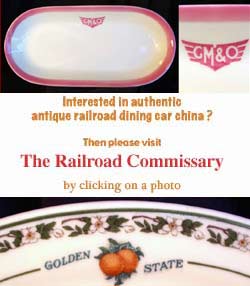The Railroad Commissary
Welcome to The Railroad Commissary's
Union Pacific / UP supplementary information page. Please feel free to send questions or comments to: rrcomm@sonic.net Relevant information, and credits, will be posted.
click here to visit the full catalog
Challenger Pattern
Timeline of UP Challenger dining china:
1936 / Challenger inaugurated / china ordered from Syracuse
1937 / "San Francisco Challenger" added / another order from Syracuse
1941, 1943, 1944, 1945, 1946 / supplemental Challenger china ordered from Syracuse
1947 / Challenger (temporarily) discontinued
1953 / Challenger reinstated with streamline cars
1954-1955 / Challenger china ordered from Shenango
1956 / supplemental Challenger china ordered from Shenango - cups only ?
1956 / Challenger combined with other trains / use of Challenger-marked china discontinued
soon thereafter / some or all remaining Challenger china used in maintenance-of-way work trains
Cheyenne / Zion / Sun Valley Pattern
In truth, so called, Cheyenne" and "Zion" patterns are the same service - the plain items have been dubbed "Cheyenne", while the brightly decorated items have been dubbed "Zion". This service was used at the Sun Valley resort, which was developed and run by the Union Pacific, so either name seems a poor choice. It would probably better to refer to "both" patterns as "Sun Valley".
Desert Flower Pattern
This pattern is often cited as an "exclusive use" pattern, but it was only an exclusive use pattern for the years that it was being ordered by the UP. Indeed, there are even pieces of this exact pattern backmarked for restaurants! Without careful study, only UP backstamped pieces can be known to be railroad dining car china. Most china in this pattern is not backmarked, which we do not stock, for this reason. Backstamped pieces are more expensive, but a better value in the long run, as their railroad heritage can easily be established beyond doubt.
Winged Streamliner Pattern
Despite the number of different maker's marks born by this pattern, Winged Streamliner was only produced by three makers, at least in one sense. They were as follows:
Syracuse seems to have been the earliest maker. They produced the pattern throughout the 1940's and as late as the mid-50's.
Scammell's, while never dated their pieces, appears to have started getting orders for this pattern in the late '40's, maybe the very early 1950's. In 1954, Sterling China bought out Scammell's. It is unclear when this change was actually reflected on the china (surely by 1959), but when the change came, Sterling used the name "Trenton China" (the same as the previous backstamp, but without the "Scammell's" name). In about 1965, Sterling changed the backstamp to their own name. The use of the Sterling backstamp lasted at least through the 1970's in all its various forms – including the current stylized "S" logo. This is the only pattern of authentic railroad china to carry stylized "S" Sterling backstamp. Mind you, that one can't really call any Winged Streamliner china made after 1971 "regular dining car" china, as 1971 is when UP turned its dining car operations over to Amtrak, but UP continued to buy the pattern, for whatever reason (special trains, business cars), apparently at least into the 1980's.
Beginning in the mid-1960's, Homer Laughlin was occasionally tapped to produce Winged Streamliner pattern china. Through the 1970's, and maybe 1980's, Homer Laughlin took a few of the orders. The Homer Laughlin china is distinct in that the logo is all brown, not green and red as found on all other Winged Streamliner china.
No Gold Stripe Variant The reason for the variant that lacks a gold stripe has been lost. The obvious advantage to such pieces is that their appearance would not deteriorate rapidly in use, as was ever a problem with standard Winged Streamliner china. The late '50's were a time when passenger service was starting to generate substantial losses, so I presume that this variation was an experiment in cost reduction. What is apparent is that they were made in batches at various times over the years. The largest numbers seem to have been made by "Trenton" (really Sterling in disguise) in the very late 1950's into the early 1960's. The logo coloration seems different than their contemporary gold stripe pieces in that the train is brown (apparently an attempt at painted gold color) rather than reddish brown - more like the Homer Laughlin colors of many years later.
It should be noted that this variation is different from worn gold strip pieces that someone has diligently tried to scrub off the gold stripe (which leaves either a reddish purple stain where the gold once was, or glaze damage). Standard Winged Streamliner china that has been so treated is simply damaged china, and has very little value. It should also be noted that, as most pieces of this variant were acquired from the Union Pacific itself, that these were not simply unfinished factory seconds or over-runs, but china that the UP actually used at some point. As standard Winged Streamliner and the no-gold-stripe variant were made at the same time, I must guess that the UP tried converting some trains to using the more economical variant, but abandoned the effort after several years.
(Thanks to Karl Swartz for a factual revision)


